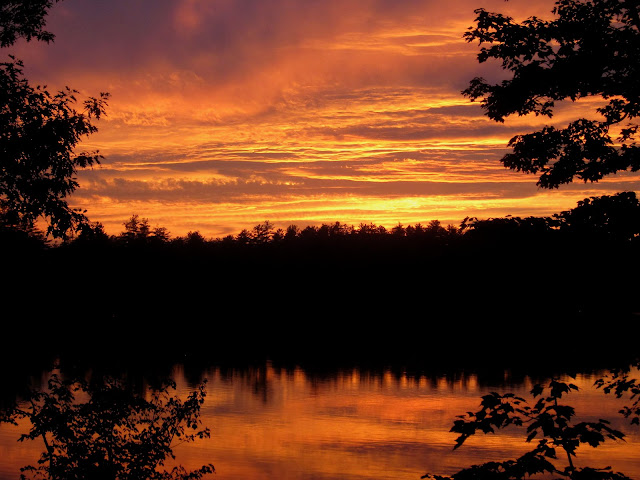We're probably just past peak around Lake Wicwas, so get them now before they're gone. They should be plentiful farther north and at higher altitudes for a bit longer; I was up in the Belknap Mountains last week and the bushes were loaded with berries.
Strawberry season is just about over but you may still find local berries at the farm stands. And the cherries are starting to ripen, but the wild black cherries, though edible, aren't worth the effort in my book.
 |
| These black cherries will turn black when ripe - if the birds and bears don't eat them first. |
And of course, the u-pick berries will be available for several more weeks, so there's still plenty of opportunity to get those local, fresh, nutrient-rich little beauties for your breakfast fruit or your dessert treats.
We spent part of this week at a beautiful lake in Maine, up near the town of Belfast on Penobscot Bay.
 |
| Lake Quantabacock |
We had a great visit with wonderful hosts and were treated to a summer's worth of lake life - sailing, kayaking, paddle boarding, a lake tour, and just visiting in a gorgeous setting. (And of course, lobster.)
Lake Quantabacook is similar in many ways to Lake Wicwas, complete with its own pair of loons, but there is one significant difference: Quantabacook has nesting bald eagles.
 |
| This eagle nest is huge - well over six feet across. |
One of the highlights of the trip was seeing the eaglet - thanks to Linda's sharp eye - though it was pretty darn big already.
 |
| The eaglet was a couple of trees away from the nest so it is likely flying now and should probably be called a fledgling. |
We didn't see either of the parents so they must have been off fishing elsewhere, perhaps in Belfast Harbor or at the nearby Passagassawakeag River. (And we think Winnipesaukee is difficult!)
 |
| Belfast Harbor |
A bald eagle doesn't fully mature and earn its trademark white head and tail for five years, so if you see a very large (six foot-plus wingspan) raptor but it doesn't have the classic look of a bald eagle, it may well be an immature bald eagle. It's good to know that loons can survive on a lake right underneath an eagle nest and still find a way to raise a family.
And that brings us to Lake Wicwas's loons. I had a very disconcerting moment when I went out for a paddle on Lake Wicwas today after returning from Maine. I came upon a single loon swimming along looking every which way with a small minnow hanging from its beak.
It swam right up to my kayak, clearly looking for a chick to feed.
That's never a good sign and I feared the worst as there was no sign of a chick to be seen. So I went on my way fearing another chick casualty, but 15 minutes later, way over on the other side of the lake I saw three floating objects, and as I got closer I could see it was the rest of the loon family.
 |
| Harley and Davidson, probably with mom, after giving me a scare. |
I don't know how or why they got so separated, but all seems to be well, and it gives me more confidence that Harley and Davidson might make it, but there's still a long way to go.
























































